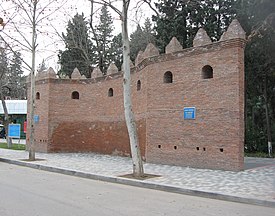| Siege of Ganja | |||||||||
|---|---|---|---|---|---|---|---|---|---|
| Part of Russo-Persian War (1804–1813) | |||||||||
 A part of Ganja Fortress | |||||||||
| |||||||||
| Belligerents | |||||||||
|
| |||||||||
| Commanders and leaders | |||||||||
|
|
| ||||||||
| Strength | |||||||||
|
Six battalions of infantry:[5] 2 battalions of Sevastopol Musketeer Regiment 3 battalions of the 17th Jaeger Regiment One Battalion from Grenadier Regiment of the Caucasus, a regiment (3 squadrons) of Narva Dragoons 165 Cossacks 700 Tatar horsemen 12 guns. | 4 guns, and about 1,700 soldiers | ||||||||
| Casualties and losses | |||||||||
| 38 killed and wounded (3 officers and 35 of the lower ranks of the Russian Army) |
3,000[6][7] - 7,000[1] inhabitants of Ganja (executed) 1,700 soldiers[8] (killed in fighting and executed) | ||||||||
The siege of Ganja (Persian: نبرد گنجه) or assault on Ganja (Russian: Штурм Гянджи) was the result of a Russian offensive in the South Caucasus intended to conquer the Ganja Khanate of Qajar Iran, which contributed to the escalation of the Russo-Persian War (1804–1813).
- ^ a b Mansoori, Firooz (2008). "17". Studies in History,Language and Culture of Azerbaijan (in Persian). Tehran: Hazar-e Kerman. p. 245. ISBN 978-600-90271-1-8.
- ^ Russia in the Nineteenth Century. Volume II of The History of Russia. Edited by M. V. Nechkina. 1953. P. 52
The khanates of Eastern Transcaucasia were in part semi-independent state structures and in part vassals of Iran, for instance the Khanate of Erevan, which had grown up on the territory of Armenia, or of Georgia, such as the Khanate of Ganja in Azerbaijan.
- ^ Fischer, William Bayne; et al. (1991). The Cambridge History of Iran. Vol. 7. Cambridge University Press. p. 332.
(..) "In Tsitsianov's attack on Ganja the Iranians saw a direct invasion of their country's territory.
- ^ Swietochowski, Tadeusz (1995). Russia and Azerbaijan. Columbia Press. p. 5.
(..) The Treaty of Gulistan, which was signed on 12 October 1813, provided for the incorporation into the Russian Empire of vast tracts of Iranian territory, including the khanates of Karabakh, Ganja, Sheki, Shirvan, Derbent, Kuba, Baku and Talysh.
- ^ Potto Vasily Alekseevich, Caucasian war from ancient times to Ermolova Book One,Tsentrpoligraf (2008),ISBN 5952431518, section VII. (PRINCE Tsitsianov), (in Russian)
- ^ Peter Avery; William Bayne Fisher, Gavin Hambly, Charles Melville (1991-10-25). The Cambridge history of Iran: From Nadir Shah to the Islamic Republic. Cambridge University Press. p. 332. ISBN 978-0-521-20095-0.
- ^ John F. Baddeley, The Russian Conquest of the Caucasus, London: Longmans, Green and Co., 1908, p. 67, citing "Tsitsianoff's report to the Emperor: Akti, ix (supplement), p. 920".
- ^ The Siege and Assault of Fortress Ganja Archived 2014-05-19 at the Wayback Machine,(in Russian)